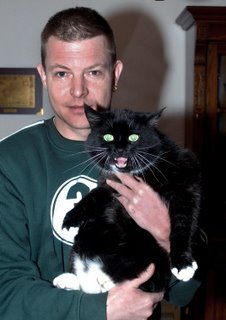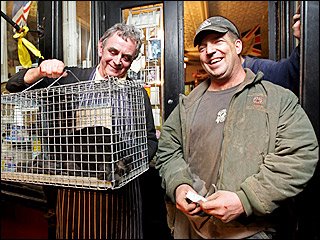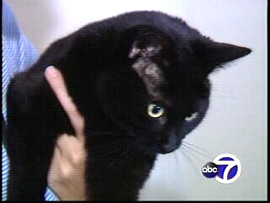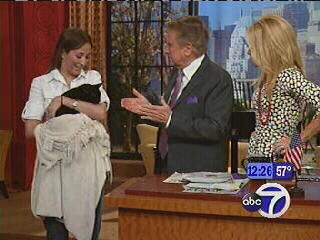Cat-Hating Monster Les Underhill and the Moneygrubbing Robben Island Museum Resume Slaughtering Cats in South Africa

The bloodthirsty South Africans have resumed slaughtering feral cats on Robben Island (See photo on the right). An assassin has been hired and told to mercilessly gun down the remaining seventy or so cats who call the windswept island off of Cape Town home.
In 2005, mass murderer Jon Kieser shot and killed fifty-eight cats but the eradication program was temporarily suspended in March of this year in order to allow the Cape of Good Hope SPCA and Beauty Without Cruelty time to trap and relocate the cats. (See Cat Defender post of March 23, 2006 entitled "South Africans, Supported by Ailurophobic PETA, Are Slaughtering More Cats on Robben Island.") On April 10th, however, the Robben Island Museum, which operates the island, reversed itself and ordered all the cats to be killed. Worst still, cats previously trapped, sterilized, and released as mousers will also be shot.
While ostensibly aimed at protecting endangered shorebirds, this mass extermination of cats, originally imported and then released into the wild by the island's Dutch and English colonizers, is in reality motivated by greed and ailurophobia.
Primarily because it once served as Nelson Mandela's gulag for twenty-seven years, Robben Island attracts more than a thousand tourists every day and thus has been designated as a World Heritage Site by UNESCO. Now, the United Nations is threatening to rescind its designation if the island does not get rid of the cats and this would cost the greedy people who run the Robben Island Museum a lot of shekels and power.
The prime mover behind the slaughter is, however, Les Underhill of the University of Cape Town (See photo below). As is the case with just about all bird advocates, he is despicable cat-hating fascist who tells nothing but lies. He also has a powerful ally in John Yeld of the Cape Argus who is incapable of writing a single story on this topic without reprinting verbatim Underhill's anti-cat screeds.
Moreover, although the editors of Yeld's sleazy, unprincipled rag gladly give space to those who agree with Underhill (PETA, e.g.), they steadfastly refuse to do the same for defenders of the cats. This is another textbook example of how fascism and dishonesty go hand and glove with the capitalist media.
The disreputable Cape Argus is owned by Independent News and Media (INM) which publishes one-hundred-seventy-five newspapers and magazines with a combined weekly circulation of thirty-one million copies in twenty-one countries on four continents. The group's flagship paper is London's Independent and in addition to its rags in South Africa it also publishes papers in Australia, New Zealand, Ireland, and India. The conglomerate also operates seventy web sites and owns one-hundred-twenty-eight radio stations with a listening audience in excess of five million people. On its web site the group brags of having assets of $4 billion euros and 10,400 employees. Whew! This crowd does not believe in leaving any stone unturned; if there is a nickel rusting away underneath an old Prince Albert tin in the Amazon jungle they are going to find it and press it into service!
Although the uninitiated may believe that they are receiving honest reporting, nothing could be further from the truth. As far as the cats on Robben Island are concerned, the only thing that readers of any of INM's publications are receiving are rehashes of Underhill's and Yeld's lies. A good case in point was Geoffrey Lean's April 23rd story in London's Independent entitled "The Last Victims of Robben Island." Lean did not go to South Africa to investigate and it does not appear that he even conducted any telephone research from London; even the quotes that he uses from Underhill are weeks -- if not months -- old. Lean is not only a bad journalist, he is dishonest. Malheursement, warped, one-sided, dishonest journalism and outright plagiarism are often the norm at The Independent.
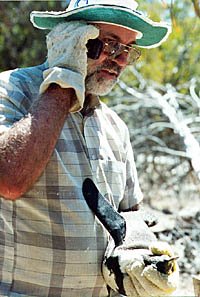
While it is undeniable that feral cats do raid the nests of some shorebirds, it is also true that it is practically impossible for a cat to kill a full-grown bird on a beach. Other than by attacking nests, the only way that a cat can catch a bird is to hide in the grass and wait for one to come near. Despite all of the lies concocted by bird-lovers, in most instances feline predation has only a minimal impact upon avian mortality. Development, pollution, climate change und so weiter all have a far greater impact but bird advocates are too dishonest and morally warped to ever tell the truth.
Other animals also prey upon birds but Underhill and his cat-hating clique refuse to acknowledge this petit fait. For instance, when Allan Perrins of the Cape of Good Hope SPCA pointed out that mice, black mole snakes, and flesh-eating rabbits are also killing birds on Robben Island Underhill laughed. "I imagine a hopping rabbit would have something of a problem stalking a bird," he told the Cape Times, another INM rag, on April 11th (See "Carnivorous Rabbits Running Wild on Island.")
In making that ludicrous statement Underhill thought that he was being cute but instead he merely demonstrated writ large his total lack of intellectual integrity. The rabbits on Robben may or may not have become carnivorous but the issue as far as the shorebirds are concerned is the raiding of their nests by predators, not stalking. Understood in this light it is perfectly clear that rabbits, snakes, mice, and other predators are just as capable of attacking nests built into the sand as are cats, especially if they get hungry enough. Also, seals are reportedly killing penguins on Robben Island but Underhill and his fascist buddies have not yet organized a death squad to go after them.
Just as it has had a deleterious effect upon the rare fauna and flora of the Galapagos Islands, tourism has also been cited as a factor in the decline of shorebirds on Robben. If the Robben Island Museum was serious about wildlife conservation it would scale back tourism but this is not about to happen. It has got to have its precious shekels just as Underhill must have his daily quota of feline blood. Of course, he most likely has his ensanguinated fingers in the till also.
Moreover, in addition to cats and rabbits, Robben Island is home to such non-indigenous animals as fallow deer, springboks, and ostriches. So far, only cats and deer have been victimized by extermination attempts. The argument over indigenous versus non-indigenous species is akin to the argument in political philosophy over natural right. Both may hold a certain surface appeal for the uninitiated but that is about all. Plants, animals, and men have been migrating from time immemorial and any attempt to assign any tract of land to any of them to the exclusion of all others is not only intellectual nonsense, as any evolutionist or anthropologist knows, but inherently fascist. Instead of rectifying conditions, such attempts serve only to exacerbate them while at the same time providing a platform for the elevation of demagogues such as Underhill and his cat-hating clique.
If this planet is to survive, man must develop a healthy respect for Mother Earth, all animals, and his fellow man. This is why that it is so important that unprincipled scoundrels like Underhill and his gang of murderers and thugs be exposed for what they are and held accountable for their crimes.
As far as the shorebirds on Robben Island are concerned, there are numerous ways of protecting them and their young without slaughtering cats. First of all, their nesting areas could be fenced off and Underhill and his gang could work shifts around the clock shooing away any cats and other predators who might venture near. This arrangement would have the added benefit of giving Underhill something to do with himself and a little manual toil might just sweat out some of the bile that has accumulated in the bottom of his black soul.
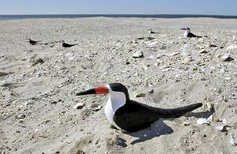
If Underhill and his clique are either too lazy or too cheap to do this, then the SPCA and Beauty Without Cruelty should be given as much time as they need in order to trap and relocate the cats to a safe environment elsewhere. Under no circumstances should the Cape of Good Hope SPCA kill any of the cats that it traps as its sister agency in Pretoria is planning on doing with ninety of one-hundred-twenty cats that it intends to trap and kill this winter at the Kolonnade Shopping Center. (See Pretoria Rekord, April 13, 2006, "Cat Colony Takes Over Kolonnade.") Apparently, the Pretoria SPCA believes that the "P" in SPCA stands for "Promotion" rather than "Prevention" of cruelty toward animals. Regardless of whatever twisted rationale it is operating on, its conduct is both disgraceful and criminal. In the land of apartheid, there apparently is not much of a distinction between animal protectors and animal annihilators.
There are far more innovative methods of protecting shorebirds than either fencing in their nesting grounds or trapping and removing potential predators. For instance, when wildlife biologists in North Carolina were faced with the problem of protecting shorebirds from both developers and predators they joined with the U.S. Army Corps of Engineers to create dozens of islands on the Outer Banks as bird sanctuaries. On these uninhabited, manmade islands, which were created out of sand dredged from navigational channels, they have deployed hundreds of plastic decoys made to look like gull-billed terns, common terns, and black skimmers (See photo above) in order to attract shorebirds looking for a place to nest.
They have also installed a sound system, powered by a solar panel and a golf cart battery, that emits a cacophony of shrill bird calls twenty-four hours a day. The decoys and sound system let the birds know that it is safe for them to nest there while signs warn boaters and fishermen not to disturb them between April and August of each year. So far, the program, which has been tried in ten other American states as well as in a dozen countries, has been a rousing success. (See Raleigh's The News and Observer, April 15, 2006, "Decoys Help Birds Rebound.")
In conclusion, Underhill's insistence that the only way to protect nesting shorebirds is to shoot cats proves that he is not only a liar but a fraud as well. Moreover, the fact that anyone as morally bankrupt and intellectually dishonest as him could hold a teaching position at the University of Cape Town since 1972 just goes to show that there is every bit as much vileness and corruption in academia as in any other segment of society.
More to the point, there can never be any peace between cat-lovers and bird advocates until the latter group stops murdering and vilifying cats. Until then, it is war!
Photos: BBC (Robben Island), Kathy Calf of the University of Cape Town (Underhill), and John Rottet of The News and Observer (black skimmer decoy).
